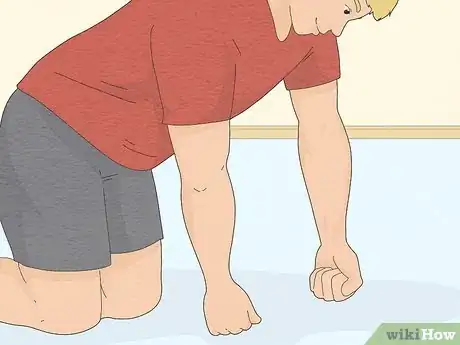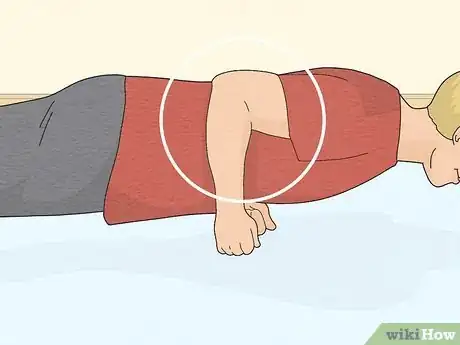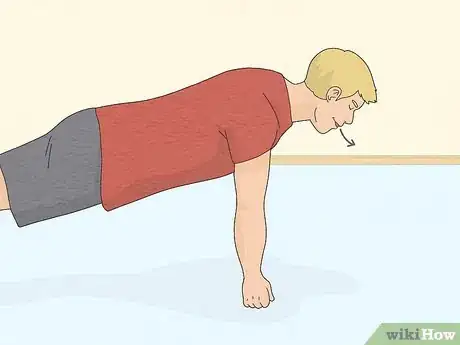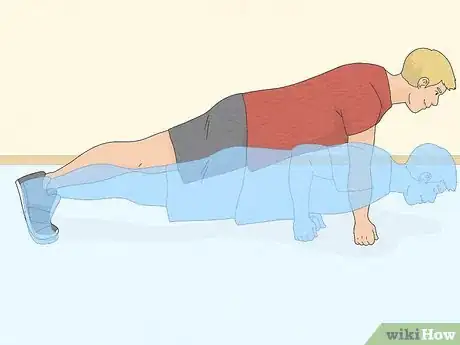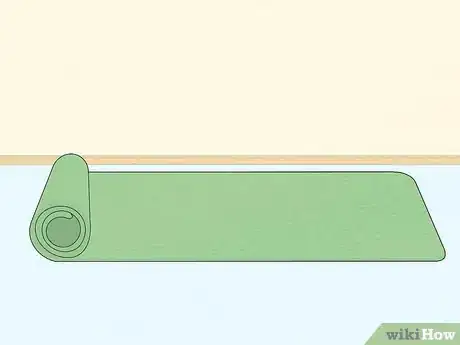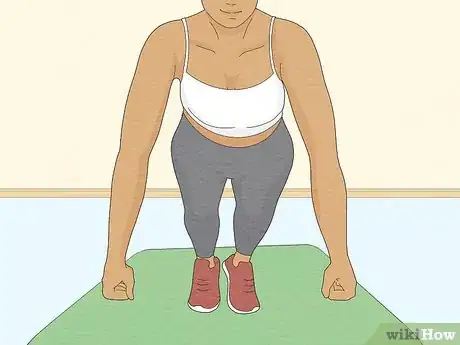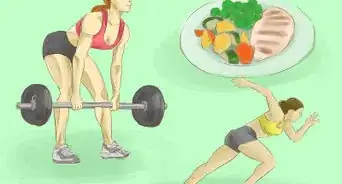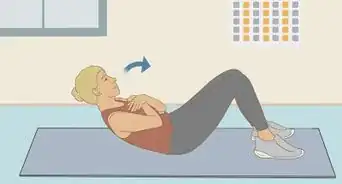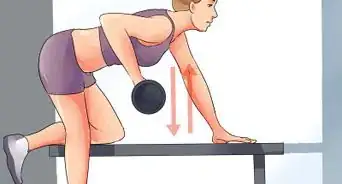This article was co-authored by Babis Kanellopoulos. Babis Kanellopoulos is a Personal Trainer and the Owner of Pod Fitness in London, UK. Babis specializes in helping clients use fitness to overcome difficulties and gain self-confidence. He has experience in kickboxing, long distance running, and martial arts. Pod Fitness sessions combine the focus of personal training with the benefits of small group, personalized, and structured training.
There are 8 references cited in this article, which can be found at the bottom of the page.
This article has been viewed 30,746 times.
If you’re looking for an exercise that will give you hands of steel and a killer workout, look no further than the knuckle pushup! There’s a reason why they’re so popular in martial arts such as kung fu—they work. Knuckle pushups have all the benefits of standard pushups, with the added bonus of toughening up your knuckles and strengthening your wrists. The basic technique is pretty simple, and there are a few variations you can try out to help you master the exercise.
Things You Should Know
- Start your pushup by clenching your hands into tight fists with your thumbs wrapped over your index and middle fingers.
- Once your hands are in fists, put your knuckles flat on the ground so your shoulders, elbows, wrists, and hands form a straight line.
- Holding yourself up on your hands, extend your legs behind you and lift onto the balls of your feet, keeping your back as straight as possible.
- Bend your elbows and lower yourself down until your chest almost touches the floor, but be sure to keep your elbows close to your body.
- When you get to the bottom of the exercise, push down into your knuckles and lift yourself back up until your arms are straight again.
Steps
Basic Knuckle Pushups
-
1Clench your hands to make a fist. Make a proper fist by extending all 4 fingers, curling them into your palm, and then folding your thumb down across the top halves of your index and middle fingers. Clench both hands into tight, sturdy fists to help support your wrists.[1]
- Keep your thumb wrapped tightly over your fingers to help support and strengthen your fist.
- Squeeze ‘em tight! A tight fist makes a tight wrist, which can help prevent injuries.
-
2Place the flat part of your knuckles on the ground shoulder-width apart. Get down onto the floor and press the surface of your knuckles into the ground. Space your fists out shoulder-width apart so your knuckles, wrists, elbows, and shoulders form a straight line.[2]
- Proper alignment is key to performing the exercise properly and will help you avoid potential injuries.
- If it helps, you can wear padded gloves or place a yoga mat on the ground to make it more comfortable on your knuckles.
Advertisement -
3Stretch out your body in a straight line. With your knuckles pressed into the ground, extend your legs behind you. Keep your back flat, your core tight, and your head up to keep everything in proper alignment.[3]
- Avoid having your neck or shoulders sag, which could lead to an injury.
-
4Come up on the balls of your feet. Distribute your weight evenly on both feet so you’re balanced. Keep your feet close together and flex your toes so you’re supported on the balls of your feet.[4]
- Keep your back, shoulders, and feet in a straight line.
- This is also known as the plank position.
-
5Inhale then lower your chest to just above the ground. Take a big breath and then carefully begin to lower yourself down, maintaining control throughout the exercise. Stop just before your chest touches the ground and pause for a brief moment at the bottom of the movement.[5]
- Try not to let your body just fall down to the ground.
-
6Keep your arms close to your side so they don’t flare out. As you lower down, keep your elbows close to your side to help prevent them from protruding. Avoid slumping or sagging down at your shoulders or chest to help prevent potential injuries.[6]
- If you use bad form, you won’t get as good of a workout and you could strain your joints and hurt yourself.
- Don’t push yourself too hard! If your technique starts to break down, take a rest, and then return to the exercise. Or try an easier variation such as doing them from your knees.
-
7Exhale as you push yourself away from the ground. Drive through your knuckles and push your chest away from the ground. Exhale as you push to keep tension throughout your body and prevent yourself from holding your breath. Continue pressing until you return to the starting position to complete 1 rep.[7]
-
8Do 2-3 reps 3-5 times a week to slowly build knuckle strength. If you’re new to the exercise, work on establishing a solid foundation and building up your knuckles and wrists over time. Work your way up to 10 solid reps and try adding multiple sets of 8-10 reps to get a really good workout.[8]
- Make sure you keep the rigid form and solid technique as you work your way to more and more reps.
- Don’t do knuckle pushups if you have wrist or knuckle pain. You could make the problem worse.
-
9Move your hands just inside of shoulder-width to up the difficulty. Target your triceps and make the exercise a little more challenging by bringing your knuckles in so they’re closer together but you can still pass your body between them. Come up on the balls of your feet and do the exercise as usual. You’ll notice the extra work your triceps have to do![9]
- Save this variation until you’ve mastered the basic technique.
- Shoot for getting a full set of 10 reps. Beast!
Easier Variations
-
1Perform the exercise on padded mats to make it more comfortable. Try out the exercise on a padded floor or yoga mat so there’s less pressure on your knuckles and wrists. Use good technique and choose a variation that works for you.[10]
- If you’re super-duper new to knuckle pushups, trying them out on your knees with a padded mat is a great way to go.
-
2Try the exercise on your knees if you can’t do the full version. Keep your knuckles, wrists, elbows, and shoulders in alignment and space your hands out shoulder-width apart. Lower your chest to the ground, stop just before the floor, and then press yourself up to the starting position.[11]
- This variation puts a lot less pressure on your knuckles and wrists and is great if you’re new to the exercise.
- Shoot for 2-3 sets of 3-5 reps if you’re just starting out. You can work your way up from there.
-
3Widen your arms outside shoulder-width for an easier variation. Make a tight fist and place your knuckles a little bit wider than shoulder-width apart to shorten the range of motion. Then, do the exercise as you normally would, and you’ll notice that the shortened range of motion makes it a little bit easier.[12]
- This is a great option if you’re ready to start trying the full exercise.
- See how a few reps feel. Aim for a couple of sets of 3-5 reps and work toward getting 10 reps in a set.
-
4Do pushups on dumbbells for less pressure on your wrists. Take a pair of dumbbells and place them on the ground so the handles are parallel and they’re shoulder-width apart. Grip the handles to form a fist that doesn’t contact the ground. Try the exercise on your knees or by using the basic technique for an option that won’t kill your wrists or knuckles.[13]
- Shoot for 2-3 sets of 10 reps.
- Choose dumbbells that are stable and won’t roll away when you do the exercise.
Expert Q&A
-
QuestionHow are knuckle push-ups beneficial?
 Babis KanellopoulosBabis Kanellopoulos is a Personal Trainer and the Owner of Pod Fitness in London, UK. Babis specializes in helping clients use fitness to overcome difficulties and gain self-confidence. He has experience in kickboxing, long distance running, and martial arts. Pod Fitness sessions combine the focus of personal training with the benefits of small group, personalized, and structured training.
Babis KanellopoulosBabis Kanellopoulos is a Personal Trainer and the Owner of Pod Fitness in London, UK. Babis specializes in helping clients use fitness to overcome difficulties and gain self-confidence. He has experience in kickboxing, long distance running, and martial arts. Pod Fitness sessions combine the focus of personal training with the benefits of small group, personalized, and structured training.
Personal Trainer Knuckle push-ups require you to complete a bigger range of motion in order to finish a full press-up.
Knuckle push-ups require you to complete a bigger range of motion in order to finish a full press-up. -
QuestionAre knuckle push-ups bad for you?
 Babis KanellopoulosBabis Kanellopoulos is a Personal Trainer and the Owner of Pod Fitness in London, UK. Babis specializes in helping clients use fitness to overcome difficulties and gain self-confidence. He has experience in kickboxing, long distance running, and martial arts. Pod Fitness sessions combine the focus of personal training with the benefits of small group, personalized, and structured training.
Babis KanellopoulosBabis Kanellopoulos is a Personal Trainer and the Owner of Pod Fitness in London, UK. Babis specializes in helping clients use fitness to overcome difficulties and gain self-confidence. He has experience in kickboxing, long distance running, and martial arts. Pod Fitness sessions combine the focus of personal training with the benefits of small group, personalized, and structured training.
Personal Trainer Not necessarily, but they can put a lot of extra pressure on your wrists. If you don't want to strain your wrists, try doing elevated push-ups, or elevating yourself with push-up handles or a medicine ball.
Not necessarily, but they can put a lot of extra pressure on your wrists. If you don't want to strain your wrists, try doing elevated push-ups, or elevating yourself with push-up handles or a medicine ball.
Warnings
- If you’ve had a recent wrist injury, talk to your doctor before you try knuckle pushups to make sure they’re safe for you.⧼thumbs_response⧽
References
- ↑ https://www.stack.com/a/are-knuckle-push-ups-worth-it
- ↑ https://workingmanfitness.com/how-to-perform-bare-knuckle-push-ups/
- ↑ Babis Kanellopoulos. Personal Trainer. Expert Interview. 6 July 2021.
- ↑ https://workingmanfitness.com/how-to-perform-bare-knuckle-push-ups/
- ↑ https://workingmanfitness.com/how-to-perform-bare-knuckle-push-ups/
- ↑ https://www.stack.com/a/are-knuckle-push-ups-worth-it
- ↑ Babis Kanellopoulos. Personal Trainer. Expert Interview. 6 July 2021.
- ↑ https://workingmanfitness.com/how-to-perform-bare-knuckle-push-ups/
- ↑ http://primalstride.com/knuckle-push-ups/

